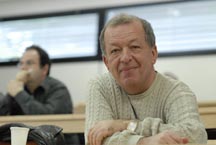An article from the summer 2010 issue of Exchange magazine
 UNC Charlotte professor Michael Klibanov uses mathematics to see through walls. An oversimplification of the process? Perhaps, but the end result is one that has piqued the interest of the U.S. Army Research Office (ARO). They hope to use Klibanov’s work to detect and identify Improvised Explosive Devices, or IEDs, particularly in Iraq and Afghanistan.
UNC Charlotte professor Michael Klibanov uses mathematics to see through walls. An oversimplification of the process? Perhaps, but the end result is one that has piqued the interest of the U.S. Army Research Office (ARO). They hope to use Klibanov’s work to detect and identify Improvised Explosive Devices, or IEDs, particularly in Iraq and Afghanistan.
With an initial grant from the ARO, Klibanov developed an algorithm that could theoretically estimate the materials in an object based on the measure of their “dielectric constants” when probed with very short microwave pulses. The dielectric constant of a material is an expression of the extent to which it concentrates electric flux, or can store electrical energy. While this may read like Greek to those of us outside the field, the upshot is this: whatever a material’s dielectric constant is, it measures higher for an explosive like that in an IED than for pretty much any other substance, such as cloth, or wood, or plastic, which may be encasing it; therefore it should be detectible, Klibanov theorized.
After sending microwave pulses through an object and then measuring the return of the many scattered pulses, the trick is trying to figure out what the object is, based on these non-invasive measurements. That’s where the mathematics comes in. Klibanov developed an inverse algorithm to model the scattering and make an estimate as to what a map of the object’s dielectric properties may be. Technically speaking, Klibanov used a mathematical process called a “globally convergent numerical method for coefficient inverse problems.” This is an obviously highly complicated process for a highly complicated problem, and one that Klibanov has been working on for three years, he says.
Klibanov’s work in the complex and difficult field of inverse problems has been going on since 1973, when he was a graduate student in Russia, and it is his work in the emerging field that earned him the highly prestigious Russian degree “Doctor of Science and Mathematics,” one that many academics don’t receive in a lifetime. His long experience with inverse problems was essential to his work for the ARO, due to the very nature of the problem at hand, which is that you don’t know what you’re dealing with and have to solve the problem backward.
When Klibanov received an ARO grant to prove his mathematical theory experimentally, he partnered with professor Michael Fiddy at UNC Charlotte’s Center for Optics and Optoelectronics. Together they used equipment that sent extremely short pulses of radiation through a distribution of cubes of material of unknown dielectric constant, which modeled an IED hidden inside another material. Applying Klibanov’s data analysis algorithm, they were successfully able to identify the structure’s dielectric profile with surprising accuracy and without him having any idea beforehand what materials were had used. In other words, they were able to see through a wall.
Klibanov and Fiddy are currently in talks with the Army, the DOD and Homeland Security regarding funding for further testing.
“It is a thrilling thing to me, as a mathematician, to see my work applied to solve real world problems such as these,” says Klibanov.








